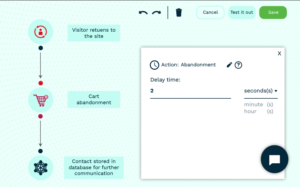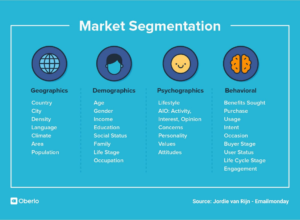Customers are not a homogeneous group. Their buying pattern is quite distinct because of the variety of products available in the market as well as their taste and preferences, which cultivates segmentation based upon similar expectations.
What is a Customer Segmentation Strategy?
The customers might be grouped together based on shared qualities. This method of grouping is referred to as segmentation, and the different groups of customers are referred to as segments.
You’ll be able to reach the correct customers with appropriate information if you do it this way. Or, to put it another way, tailor your interaction and promotion to meet the specific demands of each customer.
According to a recent poll done on behalf of Everage by Researchscape, 75% of marketers said they utilize customer segmentation to give personalized experiences to specific groups of customers, and 54% said they send personalized notifications based on user activities.
The results were quite favorable: marketers reported a 64 percent boost in customer satisfaction, a 63 percent rise in conversion rates, and a 63 percent upsurge in visitor engagement (55 percent).
What is E-Commerce Customer Segmentation?
E-commerce segmentation is based on personalized marketing while being relevant to customers and responding appropriately to their activities. It all starts with recognizing and working with your customers’ variances in behavior and curating the supply for the demand creation.
Customer segmentation based on just demographics is a thing of the past. Curated below are 10 E-Commerce customer segmentation strategies that one can follow to achieve desired results:
1. Identify the Loyal Ones
The loyal have a lot of transactions and purchases in comparison to other customers as well as they have a timeline for historical purchases, which suggests they’ve been with you for a long time and purchase frequently. The amount doesn’t matter but their regularity does, it makes us understand the brand value one has created.
In order to maintain their interest:
- Calculate the number of orders based on the price levels and provide discounts.
- Involve them in the product development process and solicit their opinion.
- Establish a points-based reward system that can be redeemed.
- Provide them exclusive deals that aren’t accessible to other customers.
2. Re-motivate the Dormant Ones
Customers who research your products for an extended period of time but do not purchase may require additional support or motivation. Contextual marketing is an excellent method to engage these customers who are in a dormant state.
For example: Let’s imagine a person stays on your site for more than 10 min, adds and discards several products, and then makes an exit without placing an order. Create a chatbot that can learn about their interests and make suggestions for the same which can solve their curiosity.
3. Monitor First-time Visitor
These are the individuals who have just discovered your website through different channels of communication or promotional advertisements. You’ll want to keep track and monitor these first-time visitors to know how they arrived on your site, as well as the actions they do and the products they look at. This will assist you in fine-tuning your suggestions.
A pro-suggestion: Never be in a hurry to persuade them to sign up for your webpage as soon as they arrive, it will annoy them. Allow them to peruse your store instead, check out different sections and only push them to sign up if they proactively add items to their cart or create a Wishlist. Promotions, rebates, free delivery, and point-based awards are all effective incentives.
4. Offer Personal Assistance to Cart Abandoners
A “What went wrong?” email doesn’t work every time, you presumably need to utilize special techniques to overcome this segment of customers. While it’s true that many carts are abandoned because the shopper is stopped, or the item went out of stock from the SKU and others depart because they don’t find the right coupons or see an additional delivery price.
After all, obviously, you’d like them to return and complete the order. However, if they don’t, you’ll need a backup plan. So, it’s better to maintain a separate track record of such cases and give them personal assistance so that they complete the order in the near future.

5. Craft Offerings to Customers based on their Personal Values
A recent study by Accenture shows, 63 percent of consumers prefers to buy products and services from companies that share their values and avoid companies that do not.
For example: Attempting to market dairy goods to someone who suffers from lactose sensitivity can only result in rejection.
On the other hand, the same client will gladly spend extra money on healthier alternatives such as soy milk or sherbet ice cream. To maintain customers based on their beliefs and crafting unique offerings for them will only boost their engagement and retention.
6. Earmark the Important Events
A customer’s everyday routine can also include event purchases. Purchases such as an anniversary or birthday gift, or any festivity all come under examples of event purchases because they are only made at specific times.
This type of strategy involves tracking a customer’s purchasing activity to build a pattern so that the targeting process can be avoided.
For example, if your store has consumers that buy nothing else from you during the year but participate in your Christmas incentives every year, you may utilize this information to promote to them in the future.
7. Recommendations Based on Purchase History
For marketers, a customer’s purchasing history is like opening heaven’s gate that leads to intriguing personalization options. Ecommerce helpdes support can also suggest complementing components and sophisticated iterations of a product to buyers, in addition to realistic and meaningful products. Those who recently purchased a laptop, for example, may be interested in buying an external keyboard and mouse, while others may be eager for an improved model of the same laptop.
8. Make Distinctions based on Payment Types
Your strategy can be based on payment with accountability, such as credit history, type of account, and form of payment in optimizing customer contact and adherence with credit policies. Customer segmentation is critical for collections departments to tailor customer contacts and assist collectors in improving their collection operations. Leading businesses are also increasingly using invoice level segmentation to prioritize invoices based on the amount payable and deadline.
9. Take the Language Segmentation Approach
In commercial websites, segmentation based on language is quite important as a diverse group of people comes in daily and there is more than one language whether it be regional or national. Language segmentation is the process of determining where one language finishes and another begins without any barriers. This is critical for all activities involving natural language processing.
10. Targeting The Right Socio-Economic Status
No amount of marketing will persuade a buyer to purchase your product if they lack the financial means to do so and it’s futile to put effort under such scenarios. Therefore, targeting an audience of the right income group will allow you to obtain people who are likely to land on your website to buy relevant products and services.
Customer Segmentation: Market Vs CRM
Market Segmentation
Market segmentation is the process of breaking your intended market into distinct groups that may be pursued. Market segmentation divides a market into subgroups based on demographics, requirements, priorities, shared interests, and other psychographic or behavioral characteristics that help to better understand the target audience.

As mentioned, it can be done in a variety of ways. Several modern ways for segmenting customers in eCommerce are discussed below:
- Geographic
Geographic segmentation is a marketing approach that aims to sell items or services to people who reside or shop in a specific area. It assumes that individuals in that area have comparable requirements, desires, and social issues. Brands may target more appropriate marketing messages and acceptable items to customers who are then informed and more inclined to purchase by learning what people in that area demand.
- Demographic
Demographic segmentation is a market segmentation approach in which a company’s core audience is divided into groups based on demographic factors such as age, gender, education, income, and so on. It assists businesses in better understanding their clients so that their demands can be met more efficiently.
- Psychographic
Psychographic segmentation is a research strategy that divides customers into groups based on psychological traits such as personality, lifestyle, social position, practices, preferences, beliefs, and mentalities.
- Behavioral
Behavioral segmentation is a type of marketing segmentation in which people are divided into groups based on a common behavioral tendency. Customers may be at the same stage of their lives, have historically purchased specific products, or have comparable responses to your communications.
Customers could be divided into segments based on:
-Their perceptions of your product, brand, and service.
-Their comprehensive understanding of the distinct products available as an offering.
-Their buying habits, such as buying just on rare occasions like festivals and sales.

CRM Segmentation
CRM tracks interaction and communication, collects sales figures, and analyses trends among certain categories to give you helpful insights into consumer behavior and opinions. You can deliver targeted marketing materials to smaller groups of people that possess at least similar interests, leading to improved retention of customers, transactions, and audience engagement.
CRM automates the above-mentioned marketing segmentation process, allowing you to reach out to the customers who are most interested in your goods and services.
Here are some reasons why merging customer segmentation with CRM software is beneficial to your business:
- Conversion Rate
- Customer Lifetime Value
- Customer Acquisition Cost
- Average Order Value
- Repeat Purchase Rate
You may approach these segments with customer-centric marketing initiatives that deliver a large return on your investment once you’ve divided your customer base into manageable bits.
E-Commerce Segmentation Strategy & Kapture’s Specialization
Kapture enables e-commerce brands with its CRM to get a deeper understanding about a certain customer, their buying habits, demographic, selections they make(filters) while maintaining a record of their transactions and product purchases, securing their personal details, and creating a tiered model to simplify enterprise functionality.
Schedule a demo today with us to get an idea about how we serve an enhanced platform to amplify your business performance.
About the Author | |
 | Raajdeep Saha Content Writer |
| Raajdeep Saha is a published poet and writer. He previously worked as a marketing executive and a creative writer for a product-based company and therefore holds technical knowledge in the marketing and advertising domain. He has worked on several blogs, ad copies, transcripts and is now contributing the same at Kapture CRM. | |
Follow Raajdeep on Social Media
| |
,
,
,
,
,
,
,
,
,
,
,
,
,









